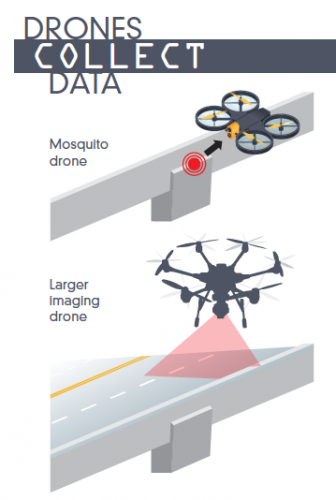For Aging Bridges, UAB Engineer Wants to Send in the Drones
Many of Alabama’s bridges are in bad shape. According to the U.S. Department of Transportation, there are about 16,000 structurally deficient bridges in Alabama. It’s a problem here and across the country. Many of the bridges are just old, and many were built when traffic and cars were lighter. But inspecting bridges takes time, skill and money. Now, a University of Alabama at Birmingham engineering professor is using a $500,000 grant from the National Science Foundation to develop a solution using drones.
Practicalities
It takes a long time to inspect any good-sized bridge, and there aren’t enough specialists or budget dollars to do them all. UAB engineering professor Nassim Uddin says that’s dangerous.

“We see a number of collapse of bridges recently, in Minneapolis, in Washington and so forth.”
Uddin says inspections become trickier and are required more frequently as bridges age. But he thinks drones could help.
“That was the challenge,” he says. “How can we use cheaper, very light sensors [to] give you a similar level of precision?”
The Plan
The idea is to mount sensors on bridges, then send drones out to upload information about the bridges’ health from the sensors. The drones themselves could scan the structures where the sensors can’t reach, too.
“Having the drones now, we don’t have to put hundreds and thousands of sensors sitting on the bridge and using lots of electricity and collecting the data day in and day out,” says Uddin.
Drones could be used for regular bridge inspections, or after storms or earthquakes.
Uddin is collaborating with researchers in Ireland and England, where he says there are fewer restrictions on testing drones in high-traffic areas. He hopes to run field tests in England this year. He’s also recently applied for a separate grant to develop the same drones to inspect buildings, homes and other structures after storms or earthquakes. Those drones could also serve as hotspot communications networks in disaster zones.
Q&A: How harm reduction can help mitigate the opioid crisis
Maia Szalavitz discusses harm reduction's effectiveness against drug addiction, how punitive policies can hurt people who need pain medication and more.
The Gulf States Newsroom is hiring a Community Engagement Producer
The Gulf States Newsroom is seeking a curious, creative and collaborative professional to work with our regional team to build up engaged journalism efforts.
Gambling bills face uncertain future in the Alabama legislature
This year looked to be different for lottery and gambling legislation, which has fallen short for years in the Alabama legislature. But this week, with only a handful of meeting days left, competing House and Senate proposals were sent to a conference committee to work out differences.
Alabama’s racial, ethnic health disparities are ‘more severe’ than other states, report says
Data from the Commonwealth Fund show that the quality of care people receive and their health outcomes worsened because of the COVID-19 pandemic.
What’s your favorite thing about Alabama?
That's the question we put to those at our recent News and Brews community pop-ups at Hop City and Saturn in Birmingham.
Q&A: A former New Orleans police chief says it’s time the U.S. changes its marijuana policy
Ronal Serpas is one of 32 law enforcement leaders who signed a letter sent to President Biden in support of moving marijuana to a Schedule III drug.







